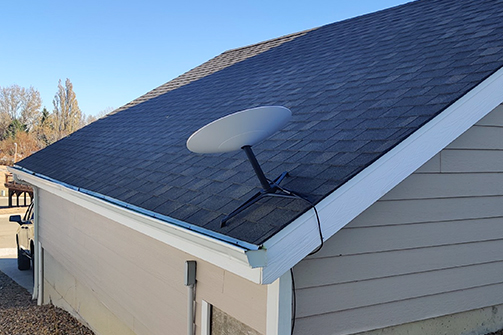Starlink New Zealand - What Does it Really Mean for Rural Kiwis?
March 29th, 2021 | Rural Broadband by Gravity

With Starlink entering beta testing stage in New Zealand, we want to shed some light on where we see Starlink fitting into the local ISP scene.
At Gravity, we are ‘satellite agnostic’. Traditionally, satellite ISPs have built their networks on a particular satellite service, selling that service whether it was the right fit for the customer or not. Gravity operates networks across a number of satellites and is closely aligned with some of the largest operators in the region, and in the world. This is an important pillar of Gravity’s goal to be New Zealand’s leading provider of space-based internet.
Here are our thoughts on the pros and cons of Starlink coming to rural Aotearoa, based on fact, not hype.
Pros and Cons of Starlink Coming to New Zealand
The Pros of Starlink
1. Low Latency Satellite Connection
The first questions Gravity asks potential customers are: does anyone in your household like to play online games such as Call of Duty or Fortnite, or is anyone involved in real time stock trading? In other words, are your internet needs latency sensitive? If yes, then traditionally satellite is not a good solution for you (unless you have no other option). SpaceX claims that Starlink’s latency will be as low as 30ms (compared with >500ms) and it has proven this in initial testing. This will be very good news for rural gamers and traders!

2. High Throughput Satellite
Low earth orbit (LEO) satellite constellations are not new, ever heard of Iridium? What is new is high throughput LEO service. To those on the ground, high-throughput loosely translates to high-speed for the end user, due to higher capacity and beam concentration. Starlink is looking at speeds of up to 100 Mbps down and 20 Mbps up, and some initial tests are showing even higher speeds.

3. Potentially Transportable
Early reports suggest that Dishy (Starlink’s antenna) can be moved from place to place, although the T&Cs state you are not to do this. Furthermore, Elon Musk has hinted at a mini version of the Starlink terminal that could be specifically designed to move around. This type of hardware and service has traditionally been very expensive and financially out of reach for most. Even the larger sized Dishy could be a game changer for RV and motorhome owners, for whom 4G-reliant solutions are currently the only option.
Together, the prospect of low-latency, high-throughput and semi-portable satellite service is very enticing – and fills an existing gap in the market of products within potential reach of Kiwis.

The Cons of Starlink
1. Unlimited Broadband Not Guaranteed
Most people’s understanding of Starlink is that it is an unlimited data service. Whilst this is currently true, it has not committed to the service being unlimited or uncapped data forever. Where Starlink documentation does refer to usage, is in its Acceptable Use Policy. The ‘Excessive Use of Network Resources’ is a rather oddly worded paragraph, but certainly hints at using network management techniques to deal with congestion or ‘excessive use’ by a subscriber.
As mentioned, there are some uncertainties around the longevity of the hardware kit you purchase. The Starlink Specifications page states that: “At the time of delivery, the Starlink Kit should be able to connect customers to the Services and to remain intact and operable for a minimum of 12 months after delivery”. It is important to note that the life of the hardware could be more limited than could be reasonably expected.

A lot of commentators are talking about the commercial viability of Starlink, which creates the greatest uncertainty and risk to consumers. Elon Musk himself talks about the fact that no LEO constellation has ever not gone bankrupt. We think it is unfair to list this as a con though, all businesses face the absolute risk of failure. It is not exclusive to, although perhaps has more dire consequences for, Starlink.
2. Hidden Costs in The Fine Print
With hyped up new services, it is easy to overlook some of that fine print. There are a few points we would encourage people to consider, prior to parting with nearly NZ$1,000. (Obvious disclaimer: the following is not intended to, nor does it constitute legal advice).
Prices may increase by up to 50 percent and performance goals (speeds) may decrease by up to 50 percent before being considered a ‘Substantial Change’ to the terms of service. This creates the possibility of paying more and getting less, with little to no recourse other than cancelling the service if you can’t tolerate the changes. Check clause 4.4 and think carefully about whether you can afford to take the risk.

Use is strictly for personal, family, household or residential use. You can’t use this for your business, for delivering professional services, or otherwise. It can be hard to know where your home-based business stops being residential and starts being business, but any breach of clause 2.1 could lead to you losing your connection and the money you invested into it. It is unclear what a Starlink “business” connection may end up costing, but we have seen a glimpse here.
The hardware (kit) is likely to become outdated relatively quickly, and you cannot sell it on TradeMe or anywhere unless you obtain SpaceX’s consent. This is a little like buying a smartphone, you know you’ll likely need to upgrade in a few years, but you won’t be able to freely sell the old one. For details, check clause 8 of the T&Cs and also paragraph 6 of the Starlink Specifications
3. Starlink is Not Locally Based
Gravity has been a satellite ISP for some years now, so we know how important local service and support is to Kiwis. Local understanding and local knowledge of rural New Zealand is crucial to delivering effective support. At this point, it appears that SpaceX will be distributing and supporting its Starlink service without local helpdesk services. You should take this into consideration or at least wait to see how effective the pre- and post-sales support structures are.

Final Thoughts
In summary, there are many aspects of Starlink to consider before making up your mind as to what Satellite Internet connection is right for you. Please feel free to get in touch with us if you have questions about the Starlink service and our team would be happy to help. Alternatively, you don’t need to wait for Starlink to get reliable and affordable satellite internet today. Gravity can get you connected anywhere in New Zealand, with plans from as little as $20 per week and a $495 setup fee - and that includes professional installation! Check our website regularly as we continue to add new space-based internet options for rural and remote Kiwis.
[Update Jan 2022] We have received and tested the Starlink connection. See our and Starlink NZ review.